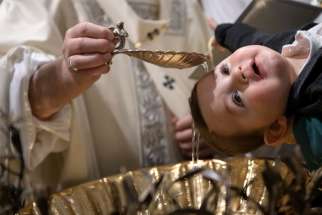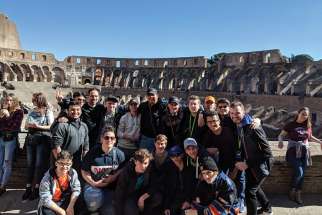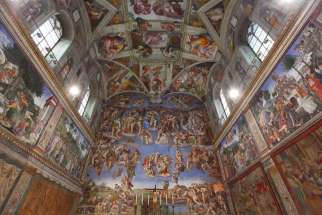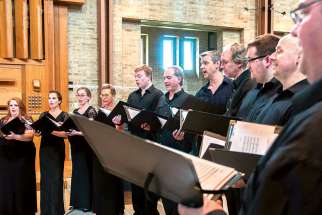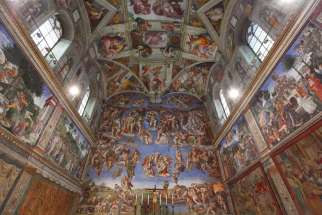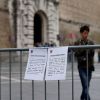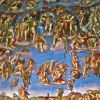Pope Francis will not baptize infants on feast day this year
VATICAN CITY -- The choral cries of newborn babies will not fill the Sistine Chapel in 2021 because the COVID-19 pandemic has forced Pope Francis to cancel his annual celebration of infant baptisms on the feast of the Baptism of the Lord.
Raphael's tapestries briefly return to Sistine Chapel
VATICAN CITY -- An artistic masterpiece conceived by the Renaissance master Raphael are on display for one week in the Sistine Chapel to help celebrate the 500th anniversary of the artist's death.
Toronto students connect with old Church in Europe
Jacob Boodoo hadn’t set foot on a plane since he was two years old so boarding a flight to Europe during March break was already an adventure for the 16-year-old.
Sistine Chapel the recording studio for papal choir's latest CD
VATICAN CITY - One of the oldest choirs in the world recorded a CD of its repertoire of sacred music surrounded by the famed frescoes of Michelangelo, Perugino, Pinturicchio and Botticelli.
50 prison inmates tour Vatican Gardens, Sistine Chapel
VATICAN CITY - Fifty inmates from a Rome jail were given a private tour of the Vatican Museums on Sunday (Sept. 13), setting the tone for Pope Francis’ visit to a U.S. prison later this month and emphasizing his concern for people on the margins.
Sounds of Sistine Chapel on Ontario church tour
If Michelangelo was listening to music while he worked on the ceiling of the Sistine Chapel, his playlist would probably sound something like Le studio de musique ancienne de Montréal’s Music from the Sistine Chapel concert.
VATICAN CITY - While enjoying a private visit to the Sistine Chapel, a group of VIP guests -- homeless people who live around the Vatican -- were surprised by a visit from Pope Francis.
VATICAN CITY - A top Vatican official received a ransom demand for the return of Renaissance-era documents by the artist Michelangelo.
Endangered Sistine Chapel to be opened for outside fundraisers
VATICAN CITY - Despite worries about the impact of millions of tourists on Michelangelo’s precious frescoes, the Sistine Chapel is opening its doors for the first time to a new kind of tourist to support Pope Francis’ charities.
Sistine Chapel feels fallout from 'Francis effect' on attendance
VATICAN CITY - The "Francis effect" has spilled over into the Sistine Chapel, bringing a surge in visitors but also increasing risks to maintenance of what Antonio Paolucci, director of the Vatican Museums, calls "the world's chapel."
VATICAN CITY - The Sistine Chapel's transformation from a world-famous tourist site to the prayer-filled space where cardinal electors will choose the next pope is under way.
Sistine Chapel turns 500, and its beauty is timeless
A Protestant colleague sent a playful e-mail from Rome a few weeks back, asking, “Don’t you think the Sistine Chapel is a little over the top?”
To which Kara Johnson, a colleague at our magazine, Convivium, gave the perfect response: “Totally over the top. Over the lip of the vault and into… heaven!”
Michelangelo’s vault of the Sistine Chapel is the greatest painted work in history, and contemplating the masterpiece from below, one beholds heaven from Earth, even as Adam gazes into the face of God at the moment of his creation. The ceiling is 500 years old, completed in 1512 after four years of painstaking work, unsurpassed artistic brilliance and a collaborative clash of titanic personalities — Michelangelo on one hand, and Pope Julius II on the other.
Thanks to the 1965 film The Agony and the Ecstasy we have a cinematic portrayal in which we glimpse the enormity of the task. Rex Harrison, playing Julius II, repeatedly demands of Michelangelo: “When will you make an end?”
“When I am finished!” Michelangelo, played by Charlton Heston, replies repeatedly and heatedly.
Michelangelo did eventually finish, and on the vigil of All Saints 1512, Julius II celebrated solemn vespers to bless the new work. Pope Benedict returned on Oct. 31 to mark a half millennium of magnificence.
On the 1,100 square metres of the ceiling, Michelangelo tells the story of creation and, with a boldness born of Christian theology and artistic genius, paints the very face of God. To see the face of God is the desire of every heart, but beyond the capacity of our vision. We therefore need the eyes of faith (theology) or an experience of beauty (art) in order to see past the limitations of the natural world.
The Sistine Chapel is the great synthesis of faith and art. It is a rare instance of perfection in human achievement — as in, for example, Bach’s Mass in B Minor — which is naturally unsurpassable precisely because it is animated by the supernatural. Grace builds on nature, and Michelangelo’s ceiling is a work of grace as well as human genius.
A great work of art is akin to a sacrament. It makes visible and tangible that which is invisible and intangible. One might even say that it renders comprehensible that which lies always beyond our comprehension. Julius II, for whatever other failings he had, knew well that the Christian faith needs art to help man encounter the divine.
“We need you,” said Pope Paul VI in 1964, at a meeting with artists held in the Sistine Chapel. “We need your collaboration in order to carry out our ministry, which consists, as you know, in preaching and rendering accessible and comprehensible to the minds and hearts of our people the things of the spirit, the invisible, the ineffable, the things of God Himself. And in this activity … you are masters. Your task, your mission and your art consist in grasping treasures from the heavenly realm of the spirit and clothing them in words, colours, forms — making them accessible.
“If we were deprived of your assistance our ministry would become faltering and uncertain, and a special effort would be needed, one might say, to make it artistic, even prophetic. In order to scale the heights of lyrical expression of intuitive beauty, priesthood would have to coincide with art,” Pope Paul added.
Pope Benedict XVI, at another meeting of artists in 2009, held again in the Sistine Chapel, called it a “sanctuary of faith and human creativity.” Benedict frequently returns to the importance of beauty for the faith. In a sceptical world no longer sure of the truth, and in a degraded culture reluctant to judge anything good, it is beauty that alone which might raise the horizon to transcendent things.
“An essential function of genuine beauty, as emphasized by Plato, is that it gives man a healthy ‘shock,’ it draws him out of himself, wrenches him away from resignation and from being content with the humdrum — it even makes him suffer, piercing him like a dart, but in so doing it ‘reawakens’ him, opening afresh the eyes of his heart and mind, giving him wings, carrying him aloft,” Benedict said in that Sistine Chapel address.
Tens of thousands pass through the Sistine Chapel each week. The chapel demands that they turn their head upward and strain their eyes to behold the glory of the ceiling, the glory of Michelangelo’s work, the glory indeed of the Lord.
Five-hundred years on and Michelangelo’s ceiling is still at work. When will it end? In heaven.


